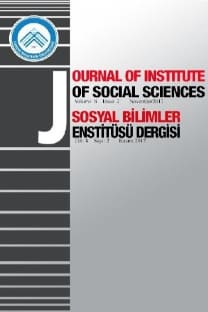Türkiye-Türki Cumhuriyetler Arasındaki İlişkilere Olumsuz Etki Eden Faktörler
Makalede, Osmanlı-Hanlıklar arasında ki ilişkilerin tarihi sürecine değinilerek Soğuk Savaş sonrası Türkiye-Orta Asya Türki Cumhuriyetleri arasındaki ilişkileri ve bu ilişkilere damgasını vuran “Türk Modeli” ve genel ilişkileri olumsuz etkileyen ve oluşan beklentileri karşılamasına engel olan faktörleri, konuyla ilgili yazılan kitap, makale ve gazeteler analiz edildi. Kurumsal ve uzman yetersizliği, taraflar arasında ki algılama farkları, İran ve Rusya ile bölgesel rekabete girilmesi, aşırı milliyetçi söylem ve yerine getirilemeyen vaatler, Türki Cumhuriyetlerin dış politika değişikliğiyle 90’lı yıllara damgasını vuran siyasi ve ekonomik istikrarsızlık gibi faktörler üzerinde durularak makale sonuçlandırıldı.
Hampering Factors in Relations of Turkey-Turkic Republics
The article touches the historical background of relations and further goes on with relations between Turkey and Turkic Republics just after the independence of the republics. The article analyzes the “Turkish Model” which became widely debated topic in literature and hampering factors such as lack of institutional preparation and experts, the difference of perceptions between the sides, entangling into regional rivalry with Russia and Iran, excessive nationalistic discourse perceived as Pan-Turkist chauvinism by the policymakers, unrealizable pledges, the policy shifts of the republics as well as politico-economic instability in Turkey during the 1990s have been presented and concluded. Findings are based on published books, article, and newspaper coverage. The article sheds light to initial relations between Turkey and Turkic Republics of Central Asia and may assist to understand the current relations better.
Keywords:
Turkey-Central Asia Relations, Ottoman-Central Asia Relations, Turkish Foreign Policy Turkic Republics,
___
- Aras, B. (2008). Turkish Policy toward Central Asia (SETA Policy Brief, No. 12-Apri12008).
- Çağ, G. (2008). Osmanlı Devleti ve Orta Asya Hanlıkları arasında diplomatic faaliyetler’de bulunan elçiler ve karşılıklı verilen hediyeler, Akev Akademi Dergisi, 12(35): 127-138.
- Davutoğlu, A. (1996). “Güçler dengesi politikası ve strateji” Aksiyon Dergisi, 25 Mayıs 1996.
- Davutoğlu, A. (2008). Stratejik Derinlik; Türkiye’nin uluslararası konumu, Küre Yayınları.
- Dénes, I.Z. (2006). Liberty and the Search for Identity: Liberal Nationalisms and the Legacy of Empires.
- Donaldson, R.H.,Joseph, L.N. (2009). “The foreign policy of Russia: changing systems, enduring interests”, ME. Sharpe.
- Eligü, B. (2010). The Mobilization of Political Islam in Turkey, Cambridge University Press.
- Fidan, H. (2010). “Turkish Foreign Policy toward Central Asia”, Journal of Balkan and Near Eastern Studies, 12(1): 109-121.
- Frazer, G. (1988). “Enver Pasha’s Bid for Turkistan 1920-1922” Canadian Journal of History 23(2).
- Gungormus Kona, G. (2008). “Reasons Behind Turkish Interest in Central Asia”, EUROSIA CRITIC, June2008.
- Hunter, TS. (2010). “Iran’s foreign policy in the post-Soviet era: resisting the new International Order”.
- Jung, D., Piccoli, W. (2001). Turkey at the crossroads: Ottoman legacies and a greater Middle East, Zed Books.
- Jung, D., Piccoli, W. (2000). Pan-Turkist Dreams and Post-Soviet Realities; Modern Day Turkey in Greater Middle East; Kemalism Faced with its Ottoman Legacy, London: Zed Books.
- Kavalski, E. (2010). “The new Central Asia: the regional impact of international actors”, World ScientiŞc.
- K1rg1zistan Delegatsıasının Turtsiaga Barışı, Bişkek Şamı , January, 1989.
- Kuru, AT. (1999). “Uluslararası Ortam ve Bölgesel Entegrasyon Teorileri Işığında Türk Birliği Meselesi”, Mim Kemal Öke (Ed.), Geçiş Sürecinde Orta Asya Türk Cumhuriyetleri, Istanbul: Alfa.
- Landau, J.M. (1995). Pan-Turkism: from irredentism to cooperation, Indiana.
- Miles, C. (1999). “The Caspian Pipeline Debate Continues: Why Not Iran?”, Journal of International Affairs (US), 53(1): 325-346.
- Ostroumov, N. (2002). Novıyistoçnik Kokondskova Hanntsvo, Dialog Sivilizatsiy, baskı 1, Bişkek.
- Özkırımlı, U., Sofos, S.A. (2008). Tormented by History: Nationalism in Greece and Turkey, New York: Columbia University Press.
- Panda, J .P. (2011). “India’s New Look at Central Asia Policy: A strategic Review”, Edited by M. Laruelle and S. Peyrouse, In Mapping Central Asia: Indian Perceptions and Strategies.
- Saray, M. (1994). Rus İşgali devrinde Osmanlı Devleti ile Türkistan Hanlıkları Arasındaki Siyasi Münasebetler (1775-1875), Türk Tarih Kurumu Basımevi.
- Shlapentokh, D. (2007). Russia between East and West: Scholarly Debates on Eurasianism.
- Trifunovska, S. (1996).The Transatlantic Alliance on the Eve of the New Millennium, Martinus Nijhoff Publishers.
- ISSN: 1309-3738
- Yayın Aralığı: Yılda 2 Sayı
- Başlangıç: 2010
- Yayıncı: Prof. Dr. Coşkun POLAT
Sayıdaki Diğer Makaleler
Kırsallık, Sürdürülebilir Kalkınma ve Kırsal Turizm
Zekayi KAYA, Murat SAYILI, Tufan BAL
Ömrünü Müziğe Adamış Bir Aydın: Ali Rıza Avni Tınaz
FİNANSAL KÜRESELLEŞME SÜRECİNDE MERKEZ BANKACILIĞI VE PARA POLİTİKALARI
Suat OKTAR, Erkan TOKUCU, Zekayi KAYA
Küresel Ekonomik Kriz ve Etkileri: Tokat İli Merkez İlçe Gıda Sanayi Örneği
Türkiye’de Büyüme ve Enerji Tüketimi Arasındaki Nedensellik İlişkisi: 1970-2010
